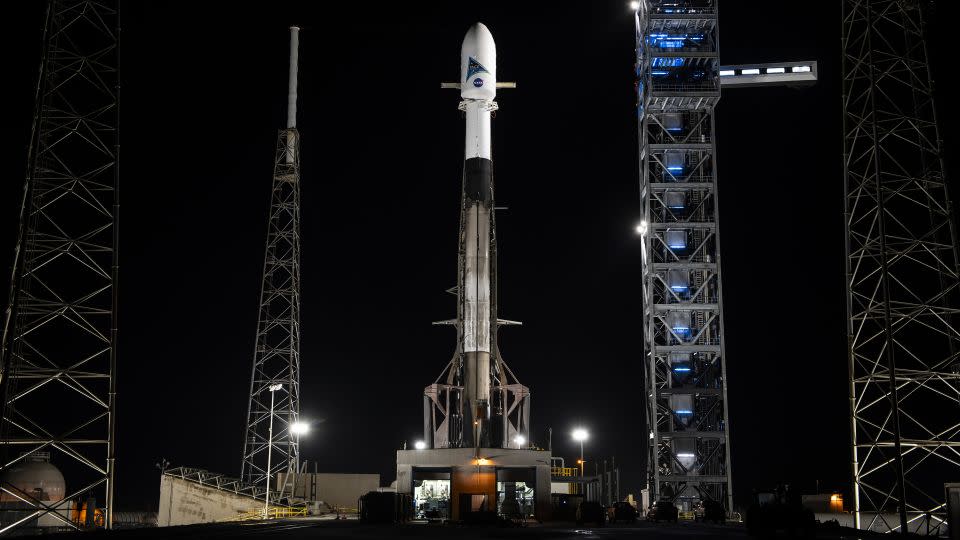Sign up for CNN’s Wonder Theory science newsletter. Explore the universe with news about fascinating discoveries, scientific developments and more.
A revolutionary new satellite that will provide unprecedented insight into Earth’s microscopic marine life and tiny atmospheric particles is ready for launch.
The NASA PACE mission, or Plankton, Aerosol, Cloud, and ocean Ecosystem, will launch Thursday at 1:33 a.m. ET aboard a SpaceX Falcon 9 rocket from the Cape Canaveral Space Force Station in Florida. The launch will be streamed live on NASA’s website and YouTube channel.
Currently, weather conditions are 95% favorable for the launch. The launch, initially scheduled for Tuesday morning, was postponed twice due to poor weather conditions at the launch site.
Scientists began imagining a way to better understand how oceanic and atmospheric processes shape the planet about 20 years ago, says PACE project scientist Jeremy Werdell.
The mission will shed light on how aerosols and clouds, as well as phytoplankton in the ocean, serve as indicators of ocean health and global warming. PACE’s three instruments, including two polarimeters and one camera, will capture a rainbow of data across different wavelengths of light, allowing “us to see things we’ve never been able to see before,” said Karen St. Germain, director from NASA’s Earth Sciences Division.
“What we’re doing here with PACE is really the search for the microscopic, largely invisible universe in the sea and the sky, and to some extent on land,” Werdell said.
Although designed as a three-year mission, PACE has enough fuel to orbit and study Earth for a decade. The spacecraft will join a fleet of more than 20 NASA Earth science missions orbiting our planet, collecting data on oceans, land, ice and the atmosphere to provide greater insight into how Earth’s climate is changing.
Together, missions like PACE and the International Surface Water and Ocean Topography Mission, known as SWOT, launched in 2022, could also change the way researchers understand Earth’s oceans.
“We are undeniably in the midst of a climate crisis,” said Pam Melroy, NASA’s deputy administrator. “Our planet is undergoing transformative changes, from the wave of extreme weather events and devastating wildfires to rising sea levels. NASA is not just a space and aviation agency. We are a climate agency. We take advantage of the unique vantage point of space to study our home as a holistic planet and collect vital Earth science data. This information is then available to people around the world, allowing them to make informed decisions about how we can protect our planet and its inhabitants for generations to come.”
Aerial photographs on the Earth’s sky
In January, NASA and others announced that 2023 was the hottest year on record, part of an overall trend in which global temperatures have warmed over the past decade, said Kate Calvin, chief scientist and senior climate adviser at NASA.
The warming is largely caused by greenhouse gases such as carbon dioxide. After it is released, carbon dioxide is absorbed by the land and oceans, but some of it remains in the atmosphere, trapping greenhouse gases that warm the planet.

“One of the great things about a mission like PACE is that it’s going to give us a better understanding of the exchange of carbon between the ocean and the atmosphere,” Calvin said.
But other factors contribute to warming, including aerosol particles in the atmosphere that are collectively made of pollutants, dust, smoke and sea salt. Aerosols can reflect or absorb sunlight and influence cloud formation, Calvin said.
Aerosols play a huge role in Earth’s weather, air quality and climate, St. Germain said.
“They come from sources such as dust blowing from the Saharan forest fires and even from human activities,” St. Germain said. “They seed clouds that can grow into hurricanes over the Atlantic Ocean, but they also reflect a lot of the sun’s energy. They will therefore play an important role in the long-term stability of the Earth’s climate.”
Aerosols can contribute to the poor air quality that causes chronic conditions such as asthma, and understanding the composition of aerosols and their location in the atmosphere can help identify polluted air hotspots and provide better warnings, says PACE atmospheric scientist Andy Sayer .
The two polarimeter instruments on PACE will help scientists study the particle size, composition and amount of aerosols in Earth’s atmosphere over a range of wavelengths to provide a detailed portrait of the most problematic areas.
Mapping microscopic life from space
About 70% of the Earth’s surface is covered by oceans, and these vast bodies of water typically raise more questions than answers – but scientists hope PACE can help change that.
“In many ways we know more about the surface of the moon than we do about our own oceans,” St. Germain said. “PACE will be the most advanced mission we have ever launched to study ocean biology. It’s going to teach us about the oceans the same way Webb teaches us about the cosmos.”
From orbit, PACE will look for the light reflected from tiny organisms called phytoplankton to see where they thrive floating on the surface of Earth’s oceans. The mission carries the Ocean Color Instrument. It will, for the first time, use more than 100 different wavelengths of light to study phytoplankton on a global scale and identify different species, including some that pose a threat to other life forms, from space.


Phytoplankton form the basis of the marine food web. Without the tiny organisms, that web would collapse and a lack of global fishing could have devastating consequences for humans, NASA said.
These microalgae use photosynthesis to absorb carbon dioxide and sunlight, generating oxygen and carbohydrates that nourish all types of marine life. Phytoplankton began photosynthesis more than 3 billion years ago, long before trees and plants, and have contributed about 50% of all the oxygen ever produced on Earth, according to NASA.
Although phytoplankton play an important role in removing carbon dioxide from the Earth’s atmosphere, some species can also be harmful. Algal blooms can be critical to the marine food web, such as those in the Arctic, but some algae blooms produce dangerous toxins that can taint drinking water and disrupt entire ecosystems. PACE’s observations can help scientists understand which species cause the toxic blooms, track and monitor them over time, and determine how to prevent them in the future.
“I like to say that PACE is a mission that will use that unique vantage point of space to study the smallest things that have the biggest impact in the oceans,” St. Germain said.
For more CNN news and newsletters, create an account at CNN.com